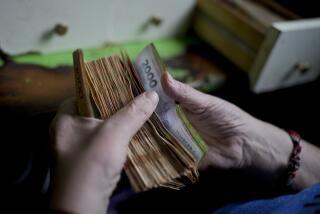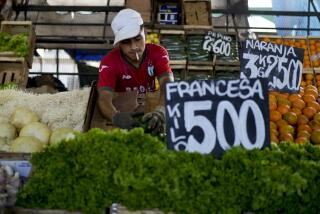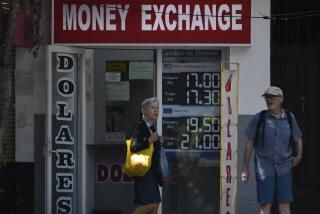Buenos Aires Becomes Costly, Even to Those With American Money : Economy: Prices are rising, salaries are holding steady and the exchange rate is 25% to 40% overvalued.
BUENOS AIRES, Argentina — Hotels, movie tickets and restaurant meals used to be expensive in the local Argentine currency but a bargain to those with dollars.
Say goodby to those days.
A small ice cream cone at popular Freddo’s now fetches $1.17, and a Big Mac at $2.59 costs as much as one in New York--and that’s from a country renowned for its pampas-fattened beef and plentiful foodstuffs.
In the last year, Buenos Aires has gone from being one of Latin America’s most affordable cities to one of the most expensive.
Tomatoes cost a dollar each. Grocers claim that is because it’s winter now in the Southern Hemisphere, but there is no weather-related reason to explain why it costs $11 to dry-clean a suit or $3 a gallon for a tank of gasoline.
“Six months ago--a year ago, five years ago--my wife and I could go out to eat at one of the better restaurants for about $50. Now that could cost $150 to $200,” said Warren Kiefer, an American novelist who has lived in Argentina since 1981.
Eating at home costs more too.
“At the vegetable market last week, celery was $2.30,” said Kiefer, author of “Outlaw.” “I bought four tomatoes and wasn’t very far into a salad and I had squandered a $10 bill.”
Argentines felt the sting of higher prices first as real wages shrank in the face of annual inflation that has exceeded 100% in nine of the last 10 years. The only breaks were brief, when the government overvalued the exchange rate or awarded salary hikes that exceeded the cost of living.
People who earned dollars, Argentina’s second currency to the austral and often held in times of uncertainty, usually were protected from inflation. As the austral lost ground, the value of the dollar frequently outpaced Argentina’s cost of living.
Now Buenos Aires is expensive for Argentines and foreigners alike. Prices are rising, salaries are holding steady and the exchange rate is 25% to 40% overvalued in favor of the austral.
“This is a new phenomenon,” said Alberto Iaconis, coordinator of the Consumer Action League. “Prices are higher than they have been in years.”
A seven-minute telephone call to New York that cost $7.15 in July, 1989, cost $15.25 one year later.
A night at a four-star hotel in this capital doubled to $84. A movie ticket has tripled to more than $4. A month’s membership at the YMCA has quadrupled to nearly $60.
A three-bedroom apartment in a middle-class neighborhood that cost $800 last year now rents for $2,000.
Analysts say it’s best not to use 1989 as a comparison because of price fluctuations due to hyperinflation, food riots in May, 1989, and elections in which the then-ruling party of President Raul Alfonsin was voted out of office in favor of current President Carlos Saul Menem and his Peronists.
The value of the austral has plunged like a rock, from 17 per dollar in February, 1989, to about 6,000 per one now, while the dollar soared above its traditional value.
At one point, an ice cream at Freddo’s cost about 40 cents, a Big Mac 50 cents, a movie ticket slightly more. A ride in a subway, bus or taxi cost pennies.
Now prices in australs and dollars have leaped beyond not only last year’s price, but beyond their usual values. Some Argentines say beyond reason.
A round-trip plane ticket from Buenos Aires to the resort mountain city of Bariloche, 1,000 miles west, now costs about $500.
In comparison, a flight from Buenos Aires past Bariloche to Santiago, Chile, costs $180 each way.
“The normal cost for a (round-trip) flight to Bariloche is $200, $250 maximum,” said an agent at Cosulich Travel. “In April, 1989, the fare was low, too low. But now the cost is too high. It’s never been this high.”
More to Read
Sign up for Essential California
The most important California stories and recommendations in your inbox every morning.
You may occasionally receive promotional content from the Los Angeles Times.










